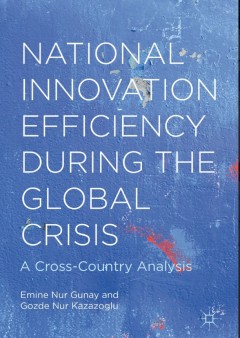Filter by

Motivation, Leadership and Curriculum Design:Engaging the Net Generation and …
This book discusses the links between the basis of motivational, leadership and curricular constructs with regards to 21st century and net-generation learning. It brings together recent developments in motivation, educational leadership and curriculum design in order to offer a better understanding of what is already known and what is yet to be explored in these fields. It consists of a collect…
- Edition
- 1
- ISBN/ISSN
- 978-981-287-229-6
- Collation
- VI, 256
- Series Title
- -
- Call Number
- -

Motivation in Online Education
This work explores and explicates learner motivation in online learning environments. More specifically, it uses a case-study approach to examine undergraduate students’ motivation within two formal and separate online learning contexts. In doing so, it recognizes the mutually constitutive relationship of the learner and the learning environment in relation to motivation. This is distinctive …
- Edition
- 1
- ISBN/ISSN
- 978-981-10-0698-2
- Collation
- XXIII, 134
- Series Title
- -
- Call Number
- -

National Innovation Efficiency During the Global Crisis
What effect did the Great Recession have on innovation efficiency and the effectiveness of scarce resource management? Did countries with high GDPs and GDPs per capita sustain efficient innovation? How did the recession affect the time lag between innovation development and implementation? This book presents the most comprehensive data set in current economic literature to measure and compare t…
- Edition
- 1
- ISBN/ISSN
- 978-1-137-58254-6
- Collation
- XVII, 184
- Series Title
- -
- Call Number
- -

Energy Efficient Non-Road Hybrid Electric Vehicles Advanced Modeling and Con…
This book analyzes the main problems in the real-time control of parallel hybrid electric powertrains in non-road applications that work in continuous high dynamic operation. It also provides practical insights into maximizing the energy efficiency and drivability of such powertrains. It introduces an energy-management control structure, which considers all the physical powertrain constraint…
- Edition
- -
- ISBN/ISSN
- 978-3-319-29796-5
- Collation
- 42 b/w illustrations, 9 illustrations in colour
- Series Title
- -
- Call Number
- -

Thermal Degradation of Polymer Blends, Composites and Nanocomposites
This book delivers a deep insight into thermal polymer degradation features and put a particular emphasis on blends, composites and nanocomposites. It examines the thermal stability and the mechanism of degrading for every class of polymer substances and studies the effect on reinforcement to all classes. The book further explores the thermal stability when nano particles are added and summariz…
- Edition
- -
- ISBN/ISSN
- 978-3-319-03464-5
- Collation
- 38 b/w illustrations, 56 illustrations in colour
- Series Title
- -
- Call Number
- -

New Perspectives on Internationalization and Competitiveness
This volume showcases contributions from leading academics, educators and policymakers derived from two workshops hosted by the Interdisciplinary Center for Economic Science (ICES) at George Mason University on internationalization and competitiveness. It aims to present key areas of current research and to identify basic problems within the field to promote further discussion and research. …
- Edition
- 1
- ISBN/ISSN
- 978-3-319-11978-6
- Collation
- XV, 185
- Series Title
- -
- Call Number
- -

Theory of Vibration Protection
This text is an advancement of the theory of vibration protection of mechanical systems with lumped and distributed parameters. The book offers various concepts and methods of solving vibration protection problems, discusses the advantages and disadvantages of different methods, and the fields of their effective applications. Fundamental approaches of vibration protection, which are consid…
- Edition
- -
- ISBN/ISSN
- 978-3-319-28020-2
- Collation
- 4 b/w illustrations, 312 illustrations in colour
- Series Title
- -
- Call Number
- -

Nanotechnology: Principles and Practices
Given the rapid advances in the field, this book offers an up-to-date introduction to nanomaterials and nanotechnology. Though condensed into a relatively small volume, it spans the whole range of multidisciplinary topics related to nanotechnology. Starting with the basic concepts of quantum mechanics and solid state physics, it presents both physical and chemical synthetic methods, as well…
- Edition
- 1
- ISBN/ISSN
- 978-3-319-09170-9
- Collation
- XXIV, 403
- Series Title
- -
- Call Number
- -

Nanotechnology-Based Precision Tools for the Detection and Treatment of Cancer
This book discusses emerging nanotechnology-based tools that have the potential to dramatically impact cancer research, diagnostics, and treatment. Cancer is a complex, devastating, and debilitating disease and, although much progress has been made, novel, more effective diagnostic and treatment options are still needed, especially for advanced cancers. The ultimate goal is to detect cancer ear…
- Edition
- 1
- ISBN/ISSN
- 978-3-319-16554-7
- Collation
- X, 322
- Series Title
- Cancer Treatment and Research
- Call Number
- -

Nanotechnology to Aid Chemical and Biological Defense
This book presents research into chemical, biological, radiological and nuclear (CBRN) defense and environmental security, exploring practical implications of the research. Contributions from a diverse group of international civilian researchers present the latest work on nanotechnology problems in this area, looking at detection, protective technologies, decontamination and threats to environm…
- Edition
- 1
- ISBN/ISSN
- 978-94-017-7217-4
- Collation
- XIV, 221
- Series Title
- NATO Science for Peace and Security Series A: Chemistry and Biology
- Call Number
- -
 Computer Science, Information & General Works
Computer Science, Information & General Works  Philosophy & Psychology
Philosophy & Psychology  Religion
Religion  Social Sciences
Social Sciences  Language
Language  Pure Science
Pure Science  Applied Sciences
Applied Sciences  Art & Recreation
Art & Recreation  Literature
Literature  History & Geography
History & Geography